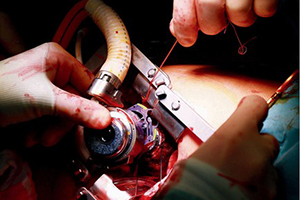Sex differences in outcomes following less-invasive left ventricular assist device implantation
Abstract
Background: Worse outcomes in women compared to men undergoing left ventricular assist device (LVAD) implantation remain an underestimated problem in heart failure (HF) patients. With device miniaturization, less-invasive LVAD implantation techniques have gained relevance, but their impact on outcomes in women is unknown. This study investigates sex-related differences in patients undergoing LVAD implantation through less-invasive procedures.
Methods: This retrospective single-center cohort study included patients who underwent isolated LVAD implantation between 2011 and 2018 through less-invasive techniques. Propensity score matching (PSM) was utilized to balance preoperative heterogeneity. Primary endpoint was two-year survival, and secondary endpoints included long-term survival, surgical outcomes and postoperative adverse events.
Results: Baseline analysis of 191 patients (females 18.3%) showed differences in terms of age [female (median, 52; IQR, 47–61); male (median, 58.5; IQR, 49–66); P=0.005], underlying diagnosis (P<0.001), INTERMACS profile (P=0.009), history of previous cardiac surgery (P=0.049) and preoperative creatinine values [female (median, 110; IQR, 71–146); male (median, 126; IQR, 9–168); P=0.049]. Over a follow-up of 460.68 patient-years, Kaplan-Meyer analysis showed better survival in females (P=0.027) and a similar probability of cardiac transplantation (P=0.288). After PSM, females showed higher needs for intraoperative fresh frozen plasma (P=0.044) and platelets (P=0.001) but comparable postoperative outcomes. No sex-related differences were noticed regarding two-year outcomes, long-term survival and adverse events. LVAD-related infections remained the most common complication with males experiencing more pump infections than women (P=0.050).
Conclusions: Patients receiving less-invasive LVAD implantation do not show significant sex-related differences in short and long-term outcomes and survival. Prospective studies are needed to evaluate the role of less-invasive techniques in reducing sex-based disparities after LVAD implantation.
Cover






